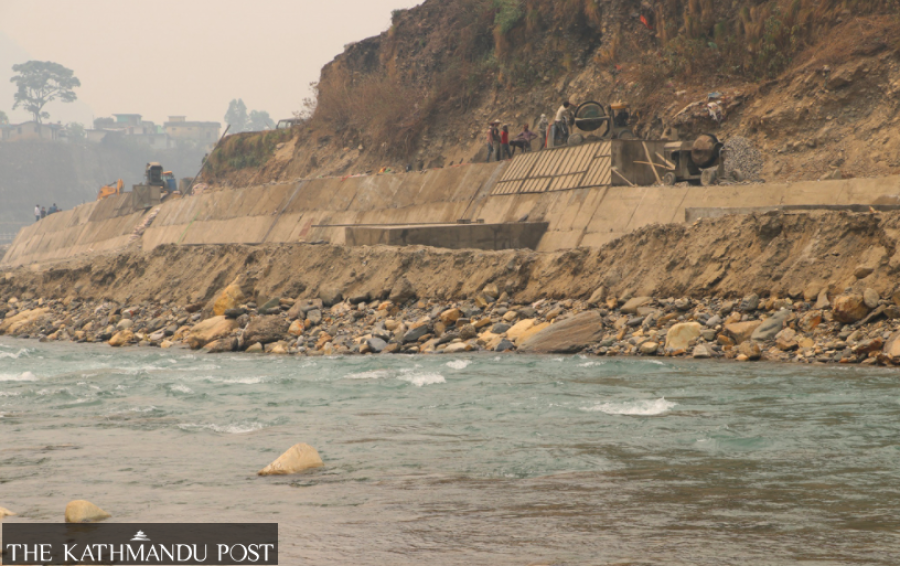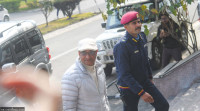National
Nepal writes to India over Mahakali border construction
In a diplomatic note, it calls for a joint inspection to assess the damage caused by blasts carried out on the Indian side but observers say India may not respond.
Anil Giri
Amid growing reports of India continuing to build a road across the Mahakali river and causing damage to a Nepali road in the process, the KP Sharma Oli government has finally written to the southern neighbour.
The construction of a road to the Manasarovar region in the Tibet Autonomous region of China through a mountain terrain has entailed blasting of rocks, thereby depositing debris into the river that marks the border between Nepal and India.
This has caused difficulties for Nepali citizens.
“After the local administration office in Darchula wrote a letter to the Ministry of Home Affairs last week to take up the matter with India to stop the blasting activities and to clean up the debris in the Mahakali river, the Ministry of Foreign Affairs has written to the government of India through the Indian Embassy in Kathmandu,” a Foreign Ministry official told the Post on condition of anonymity.
The sending of a diplomatic note to India has come after the Ministry of Home Affairs had raised its concerns more than once in the past one year.
“At least four different activities have taken place across the Mahakali river in the last one year and we have been voicing concerns with the Foreign Ministry but there was little progress,” said a Home Ministry official.
Indian officials in the past have heard Nepal’s concerns but have not always acted on them.
“After India constructed an embankment on the river in its territory, both sides had agreed in February to form a joint inspection team of technical experts this year but the team could not make much progress,” said a senior Nepali government official. “We have now urged India to revive the same technical team to inspect this new incident in the Mahakali river.”
According to a report in Kantipur, a sister publication of the Post, during a blast carried out on June 8 in the Pithoragarh area for road extension, over 150 meters of pedestrian road on the Nepali side was damaged.
Chief District Officer of Darchula Siddha Raj Joshi said he had taken up the matter with the Ministry of Home Affairs and also written to Anand Swarup, the District Magistrate of Pithoragarh, Uttarakhand, India.
“India has been building the road that will reach Manasarovar, Tibet, via Lipulekh for the last one decade. But this year, due to a series of blasts, heavy rocks and stones have fallen into the Mahakali along a two kilometre stretch of the river,” Joshi told the Post over the phone. “Therefore, the local road on our side has been affected. After our road was blocked we had to build an alternative road.”
In the letter, the Ministry of Foreign Affairs has expressed concerns over the ongoing blasts in the Indian territory that caused damage on the Nepali side, officials privy to the contents of the letter told the Post.
“We have communicated with the Indian side through a diplomatic note,” Foreign Ministry spokesperson Sewa Lamsal confirmed to the Post without sharing its content.
The Foreign Ministry has also proposed a joint inspection of the area where India is constructing several infrastructures including a strategic road and carrying out river training work along the Mahakali.
“It is difficult to clean up the Mahakali river right now because it is swollen by monsoon rains but at some point, the debris should be cleaned up,” said Joshi, the chief district officer of Darchula.
This is not the first time that Nepal has raised its concerns about the border areas with India but the southern neighbour does not always heed those concerns.
“With India, there have been numerous exchanges of diplomatic notes on several issues. Some go into execution while others are ignored,” said a Nepali diplomat.
However, officials are hopeful that India will respond this time.
“On this particular issue, we took up the matter recently and we have expressed our concerns in writing,” he said. “It can be a matter of bilateral talks.”
But observers are not hopeful as long as there is no will at the top leadership and given the current political instability in the country.
When the Oli government published a new political map of Nepal in May last year by including Lipulekh, Limpiyadhura and Kalapani areas as part of the Nepali territory, it was hailed as historic.
Coming at a time when Oli was under intense pressure within his then Nepal Communist Party (NCP), it brought the nation together.
But since then there has been no talks between Nepal and India over the territory claimed also by India.
“Oli used optics, spreading illusion among the people for some time but now he has stopped speaking about the boundary issue,” Baburam Bhattarai, a former prime minister, told the Post.
In November 2019, New Delhi unveiled its new political map incorporating Kalapani, Lipulekh and Limpiyadhura within India’s borders. Nepal protested the publication of the map and sent three diplomatic notes and offered talks for a peaceful resolution of the boundary dispute.
India, however, refused to sit for talks. Then in the first week of May last year, India’s Defense Minister Rajnath Singh inaugurated a new strategic road linking the Indian state of Uttarakhand with Manasarovar, Tibet via Lipulekh.
The recent blasts are part of improvement work on the road.
But observers argue that given Oli’s growing proximity with India in recent times, there is little likelihood of him taking up the issue.
“Is there anything left for Oli to expose his growing proximity with the Indians,” former Nepali ambassador to India Deep Kumar Upadhay said.
After unveiling the map, the Oli government had formed a nine-member task force to collect evidence of Nepal’s boundary with India in order to strengthen Nepal’s position during bilateral talks with India.
The task force has submitted its report but Nepal has failed to make India sit down for talks on the issue.
When Nepal and India held the Sixth Joint Commission Meeting at the foreign ministers level, where entire bilateral issues including the outstanding ones were discussed, no concrete meetings were planned to discuss boundary issues or other issues related to border and border security, a Nepali diplomat said.
“India has been declining our proposal to hold a meeting of the Boundary Working Group that deals with all boundary issues despite highly disputed border issues like Susta and Kalapani,” said the diplomat.
Observers say that India’s reluctance is not surprising.
“When the stature of the government slipped and reduced, the government lost the ground to raise such an important strategic and diplomatic issue with anyone,” Bipin Adhikari, who earlier worked as a member of a government task force to gather evidence on Nepal’s boundary dispute with India, told the Post.
Oli’s government has been reduced to a caretaker one since he dissolved Parliament on May 21 and called midterm elections for November. The dissolution is being examined by the Supreme Court and if the House is reinstated Oli could lose his chair.
“Even if we take up the boundary issue, India may not pay much attention given the status of the government,” said Adhikari. “It is not sure when it could be replaced by another government.”
Both Upadhyay and Adhikari, however, say there is no alternative to holding diplomatic talks with India to resolve the dispute.
“We have given inputs and references to the government on how to present our position during the talks,” said Adhikari, “The government is fully aware of it but a caretaker government has limited scope and mandate to hold talks with any government.”
Former ambassador Upadhayay echoed a similar view but expressed doubts whether Oli will hold talks as he has been too close to India since October last year.
“There is no alternative to holding talks with India but I do not see any chance of it in the immediate future,” said Upadhyay.




 12.12°C Kathmandu
12.12°C Kathmandu













%20(1).jpg&w=300&height=200)

